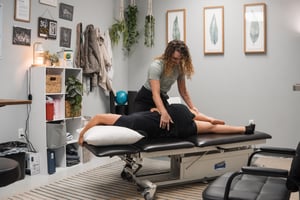Back pain is the worst. Whether it hits after sitting too long, lifting something heavy, or just...
Finding Relief from Sciatica: A Physical Therapist's Guide
If you've ever experienced the shooting pain, tingling, or numbness that radiates from your lower back down your leg, chances are you're familiar with sciatica. This common condition can be a real nuisance, making simple tasks like sitting, standing, or walking a challenge. But fear not, relief is possible, and as a physical therapist, I'm here to guide you through it. In this blog, we'll delve into what sciatica is, common causes, and most importantly, practical tips and exercises to help alleviate your symptoms and get you back to living your life comfortably.
Understanding Sciatica:
Sciatica refers to pain that radiates along the path of the sciatic nerve, which runs from your lower back, through your hips and buttocks, and down each leg. It's usually caused by compression or irritation of the sciatic nerve, often due to a herniated disc, bone spur on the spine, or spinal stenosis (narrowing of the spinal canal). There are other conditions that can also present as sciatic symptoms so make sure you know your diagnosis so you can manage it well.
.png?width=1200&length=1200&name=Untitled%20design%20(1).png)
Why Physical Therapy Matters:
When it comes to managing sciatica, physical therapy can be a game-changer. Unlike temporary fixes like pain medication, physical therapy addresses the root cause of the problem and helps strengthen muscles, improve flexibility, and correct posture—all of which are crucial for long-term relief. Everyone responds differently to treatment so there is no “one exercise” to fix your sciatica. Individualized care is the way to go when it comes to this painful condition.
Dry-needling for Sciatica:
- Dry-needling is very helpful in treating painful sciatica. You can use the needles along the nerve path to desensitize the nerve. You can also address the nerve at the location of the spine or in any muscle that might be compressing the nerve, such as the piriformis.

Dry-needling for low back pain and sciatica
Tips and Exercises for Relief:
- Nerve Gliding:
- Nerves like gliding more than stretching and you should modify your gliding and sliding so that it is not provoking your pain.
- Supine Nerve Sliders try 10 to 15 on each side
- SLUMP nerve glide try 10-15 on each side
- Posture Correction:
- Sit and Stand Tall: Avoid slouching when sitting or standing. Use a lumbar roll or rolled-up towel to support your lower back while sitting, and make a conscious effort to maintain good posture throughout the day. Using pelvic tilting can help you adjust your spine position so that you don’t feel your sciatic pain.
- Pelvic Tilting drill
- Pelvic tilting and hip hinging
- Posture Drill
- Low-Impact Exercises:
- Walking: Take short, brisk, walks with decent arm swing to help flush the spine and sciatic nerve. You might need to time your walks if walking can aggravate your symptoms.
- Aerobic exercise that doesn’t provoke your pain is important to help flush out any irritation surrounding the sciatic nerve and bring blood flow to the area for tissue healing. Overall it helps with pain management!
Conclusion:
Living with sciatica doesn't have to be a constant battle with pain. By learning your triggers you can navigate how to manage your symptoms, and by learning your root causes you can fix it. Remember to listen to your body, progress gradually, and don't hesitate to seek guidance from a physical therapist or healthcare professional for personalized advice and support. With patience and consistency, relief from sciatica is possible.
Call us today so we can discuss your sciatic symptoms and come up with an individualized treatment plan for you.
407-476-6613
-Dr. Rebecca Smith, PT, DPT, CERT-DN, Owner Core Values Physical Therapy



